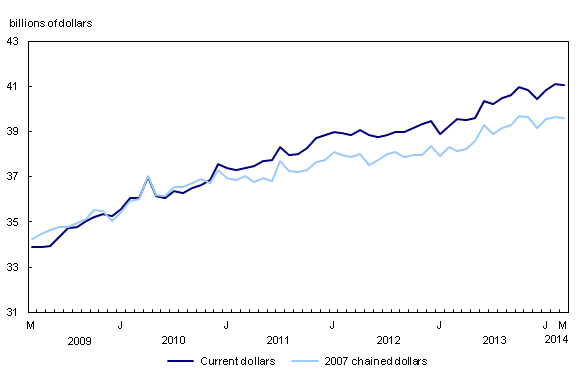Retail trade, March 2014
Archived Content
Information identified as archived is provided for reference, research or recordkeeping purposes. It is not subject to the Government of Canada Web Standards and has not been altered or updated since it was archived. Please "contact us" to request a format other than those available.
Released: 2014-05-22
Following gains in January and February, retail sales edged down 0.1% in March to $41.1 billion. Sales were lower at motor vehicle and parts dealers and clothing and clothing accessories stores. However, these declines were largely offset by gains at gasoline stations and food and beverage stores.
Sales declined in 7 of 11 subsectors representing 59% of retail trade.
In volume terms, retail sales decreased 0.2%.
Lower sales at motor vehicle and parts dealers
Among all subsectors, motor vehicle and parts dealers contributed the most in dollar terms to the decrease in March, with sales declining 0.7%. Sales were down at new car dealers (-0.6%), other motor vehicle dealers (-3.7%) and automotive parts, accessories and tire stores (-2.2%). Higher receipts were reported at used car dealers (+3.1%), where sales have been trending up since mid-2013.
Retail sales at clothing and clothing accessories stores (-1.4%) decreased for the third time in four months. After increasing in February in all store types within the subsector, sales fell at clothing stores (-1.4%) and shoe stores (-5.3%), which more than offset the 2.1% advance at jewellery, luggage and leather goods stores.
Lower sales were reported at miscellaneous store retailers (-2.0%).
Following a 1.2% gain in February, general merchandise store sales edged down 0.3% as both department stores (-0.4%) and other general merchandise stores (-0.3%) posted lower sales.
Higher receipts were recorded at gasoline stations (+0.8%) for a fifth consecutive month.
Sales at food and beverage stores rose 0.4% on the strength of supermarkets and other grocery stores (+0.4%). Higher sales at beer, wine and liquor stores (+0.4%) and convenience stores (+0.9%) also contributed to the increase.
Sales at electronics and appliance stores (+1.7%) advanced for the third consecutive month.
Furniture and home furnishing stores posted a 1.2% increase as home furnishings stores sales (+2.7%) rose for the third consecutive month. The growth in March at home furnishings stores came mainly from sales of items such as housewares, beddings and home decorations.
Sales decrease in five provinces
Retail sales were down in five provinces in March. Higher sales in the western provinces were offset by lower sales in Ontario, Quebec and New Brunswick.
Ontario (-0.6%) reported the largest decrease in dollar terms, following two months of advances.
In Quebec (-0.8%), sales declined for the third time in four months, largely as a result of lower sales at new car dealers.
Lower sales were posted in New Brunswick (-4.1%). The decline in March was principally attributable to lower sales at new car dealers, following an increase in February.
Retail sales in Alberta (+1.1%) advanced for the third consecutive month. The advance in March occurred on the strength of higher sales at new and used car dealers.
British Columbia reported a 1.1% increase from higher sales at building, material and garden equipment and supplies dealers.
It is possible to consult tables of unadjusted data by industry and by province and territory in the Tables by subject module of our website.
For information on related indicators, refer to the Latest statistics page on our website.
Note to readers
All data in this release are seasonally adjusted and in current dollars, unless otherwise noted. For more information on seasonal adjustment, see "Seasonal adjustment and identifying economic trends."
Total retail sales expressed in volume are calculated by deflating current dollar values using consumer price indexes. The retail sales series in chained (2007) dollars is a chained Fisher volume index with 2007 as the reference year. For more information, see Calculation of Volume of Retail Trade Sales.
At the end of each calendar year, seasonally adjusted monthly figures are revised to equal the sum of the unadjusted estimates. With this release, unadjusted and seasonally adjusted monthly data were revised back to January 2004. Factors influencing revisions include late receipt of respondent information, correction of information in the data provided, the replacement of estimated figures with actual values (once available), the re-classification of companies within, into and out of the retail trade industry and updates to seasonal factors, including trading day weights. Data in volume terms have also been revised back to January 2004.
The March 2014 issue of Retail Trade (Catalogue number63-005-X) will soon be available.
Data on retail trade for April will be released on June 20.
Contact information
For more information, or to order data, contact us (toll-free 1-800-263-1136; 514-283-8300; infostats@statcan.gc.ca).
For analytical information, or to enquire about the concepts, methods or data quality of this release, contact Kimberley Evans (613-951-0502; kimberley.evans@statcan.gc.ca), Retail and Service Industries Division.
- Date modified:


